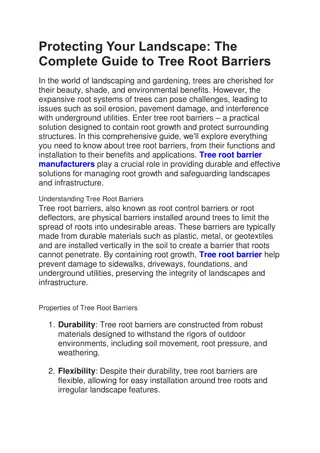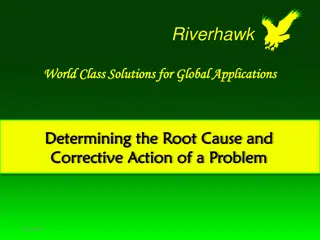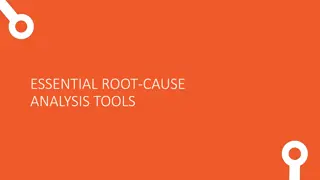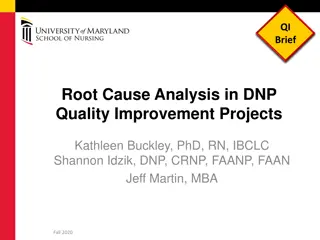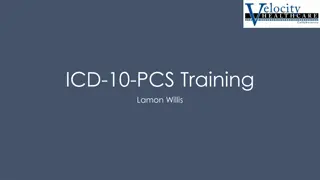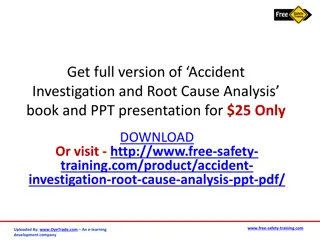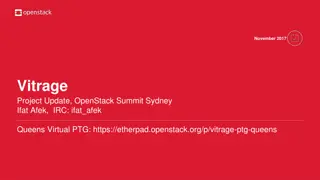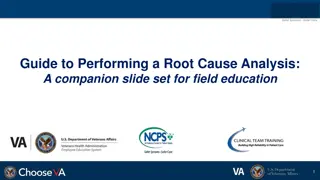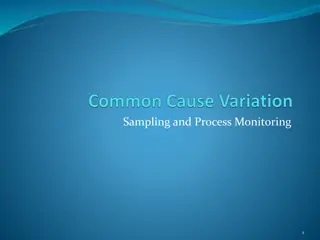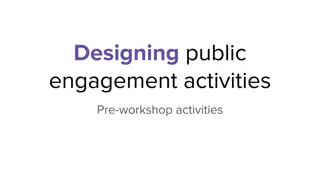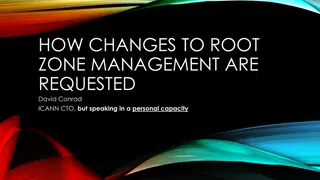Effective Risk Management & Root Cause Analysis Overview
Understanding risk management and root cause analysis is crucial for healthcare providers to enhance patient safety and mitigate potential hazards. Risk identification, analysis, evaluation, and treatment methods are essential components of an effective risk management process. Awareness of patient rights, malpractice litigation trends, and risk exposure is key in today's healthcare landscape.
Download Presentation

Please find below an Image/Link to download the presentation.
The content on the website is provided AS IS for your information and personal use only. It may not be sold, licensed, or shared on other websites without obtaining consent from the author. Download presentation by click this link. If you encounter any issues during the download, it is possible that the publisher has removed the file from their server.
E N D
Presentation Transcript
STRUCTURING AN EFFECTIVE RISK MANAGEMENT & ROOT CAUSE ANALYSIS R. I Akintola FWACS
INTRODUCTION Risk Management : IDENTIFICATION,ANALYSIS, & EVALUATION of risk and the selection of the most advantageous method of treating it.(ASHRM) Focus Components of an effective Risk Management Process Root Cause Analysis
WHY There is an increasing awareness in our society of patient rights, malpractice litigation trends, and heightened expectations about patient safety. All healthcare providers must therefore focus on enhancing the effectiveness of their risk management programs. Those who fail to do so will find themselves exposed to greater risk for failing to implement appropriate patient safety protections.
RISK - DEFINITIONS Risk The chance of something happening or a hazard being realised that will have an impact upon objectives. It is measured in terms of consequences and likelihood Standards Australia (1999) Risk in healthcare The likelihood of harm that somebody or something will be harmed by a hazard, multiplied by the severity of the potential harm. DOH (2000) An Organisation with a Memory. Risk Assessment The overall process of risk analysis and risk evaluation Standards Australia (1999) Risk Management Risk Management The culture, processes and structures that are directed towards the effective management of potential opportunities and adverse effects Standards Australia (1999) Risk Management Risk Management in healthcare Clinical and administrative activities undertaken to identify, evaluate and reduce risk of injury to patients, staff and visitors and the risk of loss of the organisation itself. Joint Commission on Accreditation of Healthcare Organisations (2000
WHAT IS RISK MANAGEMENT? Identifying, Accessing, Preventing, & Monitoring situations that could result in: Injury or liability, Financial loss, Regulatory noncompliance. Risk management should be a common thread throughout the entire organization. All are to be involved (employee & volunteer) Designated Focal Point for integration Risk manager/Quality manager/Compliance manager.
KEY POINTS Decisions : Take into account potential risks that could directly or indirectly affect patient care. Risks: Inherent in all aspects of healthcare, Properly assessed, can help health organizations, set their priorities & improve decision-making to reach an optimal balance of risk, benefit & cost. Clinical, Environmental, Financial, Political, & Reputational. For each hazard identified it is important to decide if it is significant & whether appropriate & sufficient controls or contingencies are in place to ensure that the risk is effectively minimized
RISK MANAGEMENT PROGRAM ELEMENTS Depending on the setting, a comprehensive and effective risk management program should include the following elements: Safety/security programs. Occupational Safety and Health Administration (OSHA)employee health program. Clinical Laboratory Services. Infection control. Patient& Family rights . Informed Consent procedures. Clinical standard of care/negligence. Service accessibility. Medical waste disposal.
Medical record documentation. Confidentiality policy and standards for release of medical information. Mandatory reporting requirements. Licensure requirements. Accreditation standards. Credentialing/privileging guidelines. Contract management. Monitoring of marketing/public relations/external representations. Complaint/grievance management. Employment practices guidelines.
Construction/physical plant requirements, permits, etc. Regulatory compliance activities. Professional Indemnity Issues. Retention of insurance policies.
RISK MANAGEMENT PROCESS Why, How ,When, Who Identify Services Assessment Analyze Develop & deploy mitigating measures Monitor & Evaluate CQIP
RISK MANAGEMENT PROGRAM HOW 1.Leadership Support (Empowerment) Describes the risk manager position & authority 2.Identify team (Multi Disciplinary Team) NB; Hallmark of Success Consistent & thorough processes . Commitment Regular reviews & updates
3.Review organizations policies & procedures Ensure Consistent with the standard of care delivered in the facility /practice Reflect actual operations/practices. Maintain historical archives of policies & procedures. Schedule reviews/revisions/updates as necessary. Confirm appropriate signatures with effective dates and revision dates. Delete/repeal unused or incorrect policies or procedures
4.Exposure identification mechanisms. Formal reports (incident, errors , near-misses. Formal review of: Prior claims. Patient complaints. Employee complaints. Standardized surveys/questionnaires. Inspections/surveys/audits/consultants or expert reviews. Quality assurance reports.
5.A formal & standardized incident reporting process that: Defines: What incidents must be reported. What form to use. When a report needs to be completed. Who completes the report. What needs to be reported (reportable events) & to whom. Who does the follow-up investigation. Utilizes available legal protections for confidentiality and disclosure Management medico-legal issues
6.An incident follow-up process that addressees: Who does the investigation? What was the outcome? What needs to be done to avoid the problem in the future? Documentation. 7. A tracking/trending process for: Incidents. Claims and lawsuits. Specified indicators (may be quality assurance indicators)
8.Staff training/education that: o Position/Job-specific. o Involves new-employee orientation, as well as periodic training. &Continuous Professional Dev o Uses both internal and external training. o Documents all training.
Full interaction with the following groups: Quality Assurance Committee. Safety Committee. Clinical Committee. Administrative Committee. Corporate Compliance. Board of Directors. May seem overwhelming, but can be accomplished with organizational commitment.
RISK ASSESSMENT PROCESS: AN INTEGRATED APPROACH THAT CAN BE USED AS AN IMPROVEMENT TOOL
WHY -BENEFITS OF RISK ASSESSMENT Improve work & the care delivered Focuses on reduction / mitigation of risk Compliance with Standards for Better Healthcare Better decision-making through a solid understanding of all risks & their likely impact; Plan for uncertainty & cope with impact of unexpected events Increase staff, patient & public confidence in the service Highlights the weakness and vulnerability in procedures, practices and policy changes
WHEN At various stages Early During detailed design Modification Time vary according to magnitude & complexity of the service or the changes
WHO Staff for which risk is relevant Parties affected by risks (clients & public) Roles & responsibility The risk assessor Multi- disciplinary team (MDT) clinical and non- clinical participants The recorder Ownership is key Feed risk into Risk register Focal point( designated individual to ensure follow up & close out
HOW Participants do not need to have past risk assessment experience to contribute. The approach does, however require a MDT service, or treatment. Group facilitation skills is required
Estimating probability. Subjective. NB Memorable events seem more common Constant feedback necessary to ensure accuracy Incident data, literature & other sources are useful. Effectiveness of estimated potential impact for prevented incidents. Potential to over- or under-estimate the possible impact of an incident, ( element of bias)
Balance of analysis. Don t focus exclusively on the most serious incidents or risks Lessons can be learned from low to moderate incidents or risks even near misses which occur more frequently. Resources. Ensure policies and approach match the capacity to act.
STEP 2 MAP THE SERVICES Mapping out the activities, Patient booking or treatment; identifying interactions with all component parts; identifying other changes resulting from your proposed service or treatment; changes in the activities of others should be included in the activities map and be risk assessed; collecting relevant documents including protocols, care escalation policies and patient information leaflets.
SUB-TASK Develop initial prompts: what if questions Develop record sheet Obtain risk matrix
TASK 4: REVIEW AND FOLLOW-UP Address outcome of risk assessment according to the organization's risk management policy and procedures. Review the recommendations from the assessment meeting, and agree whether to implement them as they stand or to modify Agree on method of implementation Open a register for the identified hazards & remediation actions. Identify action parties. Agree actions with relevant parties
Objective: the assessor identifies the key purposes and achievements for the organization, service or treatment. Risks: the systematic identification and assessment of risks affecting the organization, service or treatment. Management: controls for assuring that the identified risks are mitigated through targeted recommendations and/or solutions. Assurance: evidence of assurance, for example audit, patient safety incident (PSI) reporting, investigation and analysis via significant event auditing or other systematic methods.
OTHER ACTIONS Identified risk to pt safety & assess when proposing a new or different service or patient pathway. Implement & maintain appropriate control measures. Assure that risk mgt controls are effective
RISK ASSESSMENT MODELS FMEA HFMEA HACCP HAZOP BARRIER ANALYSIS & DEVELOPMENT
TYPES OF BARRIERS 1 Physical barriers: an actual physical hindrance 2 Natural barriers: barriers of distance, time or placement 3 Human action barriers 4 Administrative barriers
Identify the service Does the basic design provide appropriate safe care Does the service or pt pathway provide safe care When there is a change/modification how safe is it? Develop what if questions
ROOT CAUSE ANALYSIS Tool for identifying prevention strategies. A process that is part of an effort to build a culture of safety and move beyond the culture of blame Developed by JCI to investigate & analyze healthcare incidents An intensive process with origins in total quality mgt ? Need to find out root cause of an adverse incident tracing it back over a series of events to some fundamental problem * RCA is to use the incident to reveal gaps and inadequacies in the healthcare system Goal is to find out what happened why did it happen and what to do to prevent it from happening again
ANALYSIS OF CLINICAL EVENTS Adverse events/incidents are usually preceded by unsafe acts. For better understanding its necessary to look further, back to the error producing conditions that led to the unsafe acts and to latent failures or the decisions made by management and others which may have had a bearing on the outcome
INVESTIGATION PROCESS Sources of information Case notes, Statements from witnesses Other relevant documents Establish sequence of events Interview people involved to establish sequence of events*** contributory factors & care mgt problems as perceived by each staff Involved Patient & family members?? *Interviews should include: What happened, How did it happen ,why did it happen
INVESTIGATION PROCESS Identify obvious problems Recommend corrective actions ID action party Timeline for close out Careful mgt of family & patient (emotional & physical injury). Support as required Caregivers to be honest Believe & show empathy Ensure continuity of care Avoid blame culture. Second victim syndrome Encourage openness Share learning points. Systems analyses and support for pts and staff should be absolute priority in any risk mgt and safety strategy
Care management problems identified : actions/omissions of healthcare staff Clinical context of each of these problems: Salient clinical events or condition of the of the patient Other patient related factors that may have affected the process Contributory Factors to their occurrence: Conditions in which errors may occur within the overall organizational context
Lack of knowledge/skills & experience Task: Non availability of test results or protocols Team: Inadequate supervision, poor communication among staff Work environment; Heavy work load, inadequate staff, limited access to vital equipment.
Latent Conditions Latent Failure Contributory factors / Associated Factors Root Causes / Causal Factors Lessons Learned Recommendation
CONCLUSION For an effective Risk Management Process Identify the need Obtain management support Set up a team Identify service elements Review or develop policies/protocols/ procedures Conduct risk assessment Identify risks Open a Risk register and reporting process Process for investigating risk RCA Develop mitigating plan- barriers Put Q A process in place Continuous Quality Improvement Process
DEFINITIONS Patient safety freedom from unnecessary or potential harm Patient Safety Incident Any unintended or unexpected incident which could have or did lead to harm for one or more patients receiving NHS funded care. Unsafe Act :An act or omission, which is taken outside policy or procedure, which increases the risks of injury, failure or adverse outcomes. Hazard : A situation with a potential to cause harm Sentinel Event A Sentinel Event is defined by The Joint Commission (TJC) as any unanticipated event in a healthcare setting resulting in death or serious physical or psychological injury to a patient or patients, not related to the natural course of the patient's illness.

 undefined
undefined

























